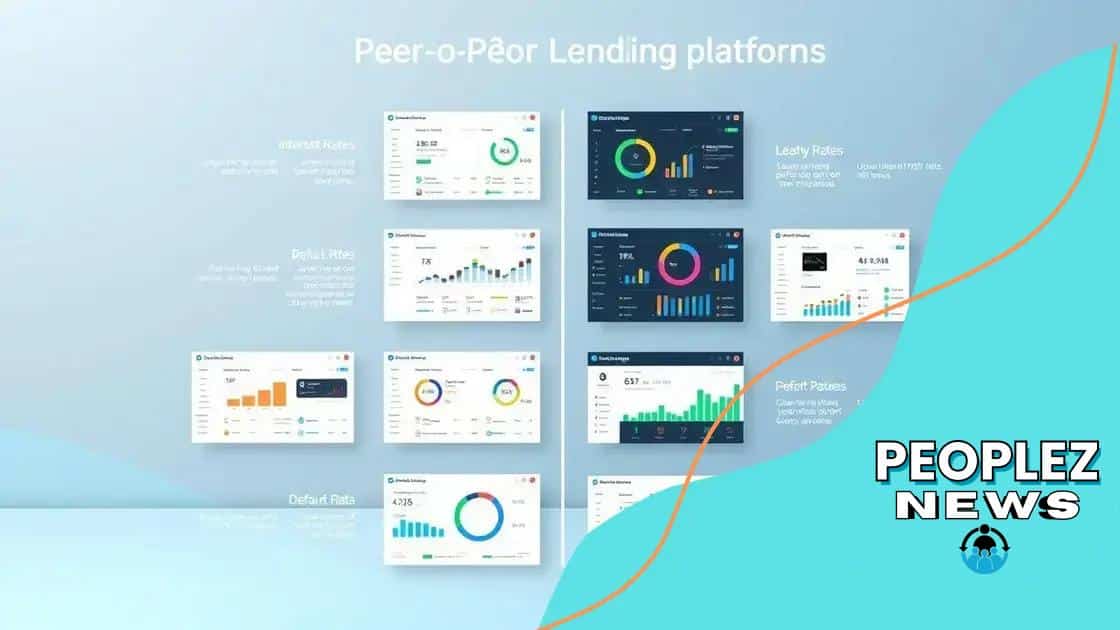Peer-to-peer lending in financial services: a game changer

Peer-to-peer lending connects borrowers directly with lenders through online platforms, offering advantages like lower interest rates and potential investor returns, while also presenting risks such as defaults and platform instability.
Peer-to-peer lending in financial services is gaining traction as an exciting alternative to traditional borrowing options. Have you ever wondered how this innovative model could change your financial experience? Let’s dive into the details to understand its implications.
Understanding peer-to-peer lending
Understanding peer-to-peer lending can change how you think about borrowing and investing. It’s a modern alternative to traditional banks. Have you ever wondered how individuals can lend money directly to each other? Let’s explore this concept.
What is Peer-to-Peer Lending?
Peer-to-peer lending (P2P) connects borrowers with lenders through online platforms. Instead of a bank acting as the middleman, individuals can support each other directly. The benefits include lower interest rates for borrowers and higher returns for lenders.
How Does It Work?
The process is straightforward. Borrowers submit loan requests detailing how much they need and why. Lenders review these requests and choose whom to fund based on their criteria. This peer-driven approach allows for more flexible terms and competitive rates.
- Direct lending without banks
- Transparency in lending terms
- Peer reviews and ratings
People are motivated to engage with P2P lending due to its potential for greater financial inclusivity. For instance, those who might have trouble getting loans from traditional banks can often find help from P2P platforms.
Investors, on the other hand, gain the chance to diversify their portfolios. By lending small amounts to multiple borrowers, they spread their risk. Moreover, many platforms offer tools to assess the creditworthiness of borrowers, making the investment safer.
Learning about peer-to-peer lending can open doors to new financial opportunities, both for those in need of funds and those looking to invest. As you consider this option, think about how it aligns with your financial goals.
Benefits for consumers and investors
Benefits for consumers and investors in peer-to-peer lending are numerous, making it an attractive option for many people. Consumers often seek loans that are both accessible and affordable. P2P lending offers competitive rates, which can help borrowers save money compared to traditional banks.
Advantages for Consumers
One of the key benefits for consumers is the lower interest rates. P2P platforms often have less overhead compared to banks, allowing them to pass savings onto borrowers.
- Faster loan approvals
- Simplified application processes
- More flexible repayment terms
Consumers also appreciate the personalization of services. Unlike traditional institutions, P2P platforms often allow borrowers to explain their financial needs more thoroughly. This creates a more human-centered approach to lending.
Advantages for Investors
On the flip side, investors find P2P lending to be an appealing option for diversifying their portfolios. By loaning small amounts to multiple borrowers, they can spread their risk while still potentially earning attractive returns.
Investors can also access detailed information about borrowers, allowing them to make informed decisions. Another benefit is the potential for lower entry barriers compared to traditional investment avenues.
- Higher returns than savings accounts
- Ability to choose specific projects to fund
- Lower correlation with stock market performance
The dynamic nature of P2P lending also allows investors to adjust their strategies based on economic conditions. This flexibility can lead to a more balanced approach to personal finance.
Comparing P2P lending platforms

Comparing P2P lending platforms is essential for anyone looking to borrow or invest money through these services. Each platform offers unique features, fees, and user experiences. To make the best decision, it’s important to understand what sets them apart.
Key Features to Consider
When evaluating P2P lending platforms, consumers and investors should look for certain key features. These attributes can significantly impact the experience and the financial outcome.
- Interest rates and fees
- Loan amounts and terms
- Borrower credit ratings
Some platforms may offer lower interest rates but come with higher fees, while others provide better perks for long-term investors. It’s crucial to read the fine print and understand how these elements play into the overall cost of the loan.
Platform Usability
The user interface and experience differ among P2P platforms. A user-friendly design can simplify the process of applying for loans or investing. Look for platforms that offer mobile access, which makes managing your finances easier.
Additionally, customer service is a vital aspect. Quick and responsive support can help resolve any issues that arise, ensuring that users feel secure and supported.
- Website and mobile app ease of navigation
- Quality of customer support
- Availability of educational resources
Exploring user reviews can also provide insights into the experiences of others. Platforms with high ratings often reflect positive experiences related to ease of use and customer service.
Lastly, understanding the unique selling points of each platform can help users make informed decisions. For example, some might focus on specific borrower demographics, while others might cater to niche investors.
Risks involved with peer-to-peer lending
Risks involved with peer-to-peer lending should be carefully considered before diving into this financial option. While P2P lending offers many benefits, it also carries certain risks that both borrowers and investors need to be aware of.
Default Risk
One of the main risks in P2P lending is the potential for borrowers to default on their loans. Unlike traditional banks, peer-to-peer platforms often lend to individuals with lower credit ratings. This can increase the risk of non-repayment.
- Higher default rates can occur in volatile economic conditions.
- Investors may lose their principal if borrowers fail to pay back.
- Platforms typically provide risk assessment tools, but these are not foolproof.
A borrower may face unexpected financial difficulties, leading them to miss payments or default entirely. Such situations can be unsettling for both parties involved.
Economic Factors
The overall economy plays a vital role in the health of peer-to-peer lending. Economic downturns can lead to an increase in defaults, impacting investors’ returns. When people lose jobs or face income constraints, they may struggle to meet their financial commitments.
Additionally, interest rates can fluctuate, affecting the attractiveness of loans. If the economy shifts suddenly, so too can the viability of P2P lending platforms.
Platform Risk
Not all P2P platforms are created equal. Some may lack the necessary regulations or financial backing to function sustainably. This platform risk can lead to sudden changes in operations, fees, or even cease operations, leaving investors at a loss.
- Investigating platform reputation is crucial before investing.
- Read user reviews to gauge reliability and customer service.
- Understand the regulations governing the platform’s operations.
Investors should diversify their investments across multiple loans and platforms to mitigate some of these risks. By spreading their investments, they can cushion against potential losses from defaults or platform failures.
The future of peer-to-peer lending
The future of peer-to-peer lending looks promising as technology and user demand continue to evolve. This financial model has gained popularity and shows potential for growth in various markets around the world.
Technological Advancements
Technological innovations play a crucial role in shaping the future of P2P lending. With the rise of artificial intelligence and data analytics, platforms can assess credit risks more accurately. By utilizing these technologies, platforms can streamline the lending process, making it faster and more efficient.
- Improved risk assessment models
- Seamless digital interfaces for users
- Automated customer support systems
As technology continues to grow, borrowers will find it easier to qualify for loans. This can expand access to credit for individuals who previously struggled to secure funding.
Regulatory Changes
As P2P lending gains more traction, regulatory bodies are likely to establish clearer guidelines. This could enhance consumer protection while ensuring that the platforms operate transparently. Regulatory changes may help legitimize the industry further and foster trust among potential users.
Compliance with these regulations could lead to safer lending practices, benefiting both borrowers and investors. Enhanced regulations can also minimize fraud and promote responsible lending.
Market Expansion
The market for peer-to-peer lending is expected to expand into emerging economies. Many regions lack access to traditional financial services, making P2P lending an attractive solution. As awareness grows and technological infrastructure improves, more individuals will join this financial ecosystem.
- Increased participation in developing countries
- Growth of niche lending platforms targeting specific demographics
- Collaboration with traditional banks and financial institutions
With the potential for global outreach, P2P lending will likely continue to evolve, adapting to different cultural and economic contexts.
In conclusion, peer-to-peer lending represents a transformative approach to financing, offering individuals the opportunity to access loans directly from others. It empowers both borrowers and investors by providing more options, lower costs, and innovative solutions. However, it’s crucial to navigate the associated risks carefully and stay informed about the evolving landscape of this financial model. As technology advances and regulatory frameworks develop, the future of P2P lending looks bright, potentially increasing financial inclusivity across the globe.
\n
\n
FAQ – Frequently Asked Questions about Peer-to-Peer Lending
What is peer-to-peer lending?
Peer-to-peer lending is a method where individuals can lend and borrow money directly from one another, bypassing traditional banks.
What are the benefits of P2P lending?
Benefits include lower interest rates for borrowers, higher returns for investors, and a more personalized lending experience.
What are the risks associated with P2P lending?
Risks include potential borrower defaults, platform instability, and economic factors that may affect repayments.
How do technology and regulations impact P2P lending?
Technological advancements improve the borrowing process, while regulations can enhance trust and safety in the lending environment.





